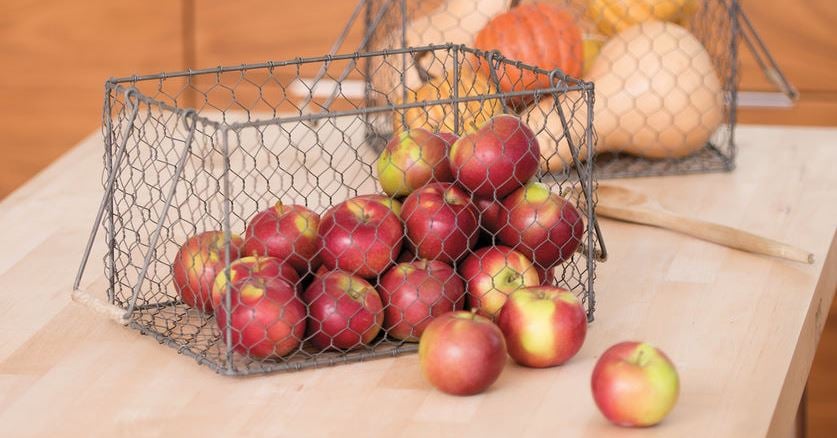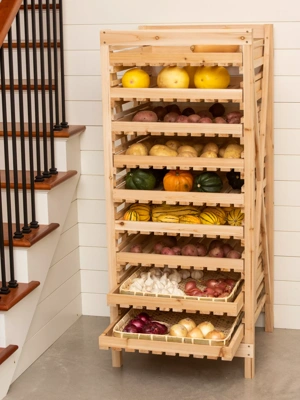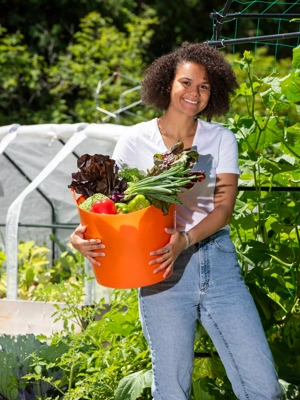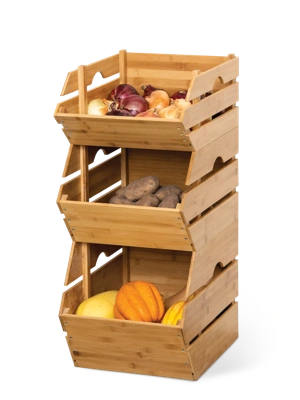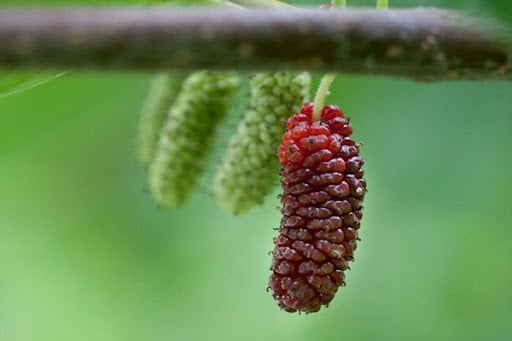Planting and Growing Fruit Trees
You don't have to own a large estate to grow a wide variety of fruits at home. If you don't have space for full-sized trees, you can plant dwarf forms of apples, pears and other fruits. Or try pruning and training trees on a trellis in the time-honored technique known as espalier. Grow a grapevine over an arbor or pergola. Plant lowbush blueberries or strawberries in a bed near the house. Even container growing is possible, giving northern gardeners a chance to grow citrus, figs and other frost-tender fruit trees.
Site Section
Fruit trees are somewhat fussy about where they're planted. If you were planting a large commercial orchard, site selection would be critical. But for a small home orchard, your best bet is to take a handful of variables into account, select the most promising site on your property, and then plant a couple of trees and give it a try.
- Soil: Fruit trees don't like wet feet, so well-drained, loamy soil is a must. They should be located where there is good air circulation so their leaves will dry quickly, since moisture helps spread disease.
- Frost: Flower buds can be easily killed by late spring frosts, so avoid siting your orchard in a frost pocket. Cold air flows downhill, making flowering fruit trees located at the bottom of a slope especially vulnerable to frost. Mid-slope is the best location, because winds are most severe at the top.
- Slope direction: Which direction the slope should face is not always clear. Southern and southwestern slopes can be hot and dry, and can cause trees to break dormancy too early, which makes them susceptible to damage from late frosts. Yet a southern slope can work well if it is protected from the prevailing winds by a windbreak on any side except the downslope one (which would block air circulation). A northerly slope may not provide enough solar exposure to evaporate moisture and promote good fruiting. In humid regions, easterly slopes can speed drying of the morning dew.
- Sun: Fruit trees need a lot of sun to grow healthy and be productive. If they are shaded by other trees or a building they will be less fruitful and more prone to insects and -disease.
Selecting Plants
It pays to seek out trees and shrubs that have some natural resistance to disease. In apples and pears the common diseases include scab and fire blight. With other fruits, such as raspberries, make sure you buy from a nursery that propagates from virus-free plants. Selecting disease-resistant plants doesn't mean that you will never experience any disease problems, but it greatly improves your chances for success.
Another crucial issue is hardiness. To make sure that the plants you purchase won't be damaged over the winter, check hardiness information before you buy. Also consider bloom time. Many fruits flower very early in the spring. If your area is prone to late frosts, such early bloomers may survive, but they will never truly thrive or reliably set fruit. To grow these plants in a marginal area, you’ll have to plant them in an especially favorable and protected site.
Buying Plants: Locally or by Mail?
Local nurseries usually sell trees in containers or with the root mass wrapped in burlap. Mail-order nurseries usually sell trees as "bareroot stock," which means that they are shipped to you in a dormant state with their roots packed in damp wood shavings.
The choice of where to buy is up to you: mail-order nurseries tend to offer more varieties than garden centers, so if you are looking for a particular cultivar or want a broad selection you should start with them. However, if you're unsure about which variety to buy, a local nursery will carry plants that will thrive in your growing area.
If you buy bareroot plants by mail, you will need to plant them in early spring, as soon as the ground can be worked, while the plants are still dormant and the water table is high. This spring planting gives the young plants a full growing season to get established before the onset of freezing weather in the fall. Trees and shrubs sold in containers by local nurseries are more forgiving in terms of planting time; they can be successfully transplanted in most areas either in the spring or early fall.
Most fruit trees will be sold as grafted stock. This means that the tree consists of at least two sections. The top part is called the scion, and is a branch cutting that has been taken from the variety of fruit you want to grow. The bottom part is the rootstock, and it is usually selected either for hardiness or the ultimate height and size of the tree. Standard rootstocks result in trees of full size (to 15 feet or more). Dwarf rootstocks limit the size of mature trees to 6 to 8 feet or so. Semi-dwarfing rootstocks produce mature trees somewhere in between the two extremes.
Dwarf fruit trees result in space-efficient plants that begin bearing fruit quickly, usually two to three years after planting. There are, however, a few disadvantages to growing dwarf trees. They have a shorter life expectancy than standard-sized trees—about 10 to 20 years on average. Because of their limited root systems, dwarf trees don't compete well with grasses and other plants, so you'll have to keep the area around them weeded and well mulched. Also, most true dwarfs are not suitable for regions in Zone 4 and colder. But for gardeners concerned with space limitations, or who live in relatively mild climates, dwarfs can be the ideal choice.
How to Plant a Fruit Tree
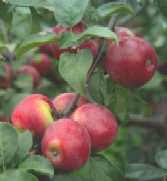 Dwarf rootstocks limit the size of fruit trees, making it easier to grow them in a small garden.
Dwarf rootstocks limit the size of fruit trees, making it easier to grow them in a small garden.- If you've ordered bareroot nursery stock, soak the plant roots in water or manure tea up to 24 hours before planting. If you can't plant within a few days after receiving the shipment, repack the plant in the damp sawdust or wood shavings it came in and store it in a cold, dark location until the ground can be worked. Never expose the bare roots of plants to wind or sun.
- Using a sharp, square-ended planting spade, dig a circle 2 feet in diameter and about 3 feet deep. Remove the sod and set it aside. Now separate the topsoil and the lighter-colored subsoil into two piles, and remove any rocks from the planting hole.
- Chop up the sod and put the pieces in the hole, grass side down, so that it doesn't come in contact with the tree roots. Cover the sod with a little topsoil.
- Set the tree into the hole. For grafted trees grown on standard rootstocks, position the tree so that the graft union, the point at which the scion and the rootstock were joined together, is 1 to 2 inches below the surface of the ground. For dwarf and semidwarf rootstocks, the graft union should be 2 to 3 inches above the soil surface.
- Fill in around the roots, using the topsoil first. Use your hands to firm the soil around the roots and eliminate any air pockets. Fill in about half the planting hole.
- Pour water into the planting hole until the soil gets quite mucky. Then, using your foot, tamp down the soil.
- Fill in the rest of the planting hole with the remaining topsoil and subsoil. Firm down the soil around the tree and make a "dish" or depression to encourage water to drain toward the tree.
- Mulch around the tree with organic matter (leaves, compost, grass clippings, etc.). Don't use fresh manure, though well-rotted manure is fine. Line the mulch in the same dish shape around the tree.
- Water the tree until the soil cannot readily absorb any more.
- Drive one or two stakes into the ground outside the root zone to mark the tree. Fruit trees grafted to dwarf rootstocks develop smaller root systems than standard-size trees and require some support. After planting dwarf trees, attach the tree to the stake using some -flexible tubing or other material.
- Prune off any side branches and cut back trees by about one-third after planting. Balled or container trees do not need to be pruned.
- Place wire-mesh "hardware cloth" or a plastic tree guard around the tree trunk to protect it from rodents and deer.
- Post-Planting. During the first growing season, water the tree regularly, giving it 5 to 10 gallons per day for the first month or so, then watering two or three times a week for another couple of months, or during dry weather. In the late fall, paint the tree bark with white latex paint diluted with water, so the bark will reflect winter sunlight and not be damages by sunscald or cracking.
Pollination
Many varieties of fruit trees and shrubs are self-fruitful: that is, they do not need to have a plant of another variety nearby with which to cross-pollinate. Other varieties (particularly those of fruits) need to have a partner in the orchard so that they will be pollinated and produce a good crop of fruit. In fact, even self-fruitful varieties often benefit from having a different variety of the same plant located nearby.
Cross-pollination doesn't mean that you will end up with weird-looking hybrid fruits. For example, a 'Cortland' apple tree will always produce 'Cortland' apples, even if its blossoms are visited by bees who carry pollen from another variety of apple or crabapple that is growing nearby. However, if you planted the seeds from that 'Cortland' apple, you would probably grow a tree that bore an entirely different kind of apple, one that was not "true to type."
Commercial orchards often rent honeybee hives to ensure good pollination during blossom time. Fortunately, there are also wild bees that do the same job. For example, the orchard mason bee (Osmia lignaria) is a good pollinator, and is found throughout most of the United States, with the exception of the Deep South.
It's very important never to spray insecticides during the blossom time of either the fruit trees or the other groundcover plants (dandelions, clovers, etc.) that may be growing near them. These toxic chemicals can kill bees and other beneficial insects. Read on for more information on nonchemical methods of pest control. Nursery catalogs and books usually provide good information on which varieties of plants need pollinators and which will produce fruit even if planted alone.
Pollination Tips
- Apples: Crabapples will cross-pollinate with apples, and in fact are often grown near apple trees for just that purpose.
- Pears: Most varieties of pears need to be cross-pollinated with a different variety. Two popular varieties, 'Seckel' and 'Bartlett', will not pollinate one another.
- Cherries: Sweet cherries and sour (pie) cherries are different species, rarely bloom at the same time, and will not cross-pollinate with one another. Unless you purchase a self-fruitful variety ('Montmorency', 'Star Stella', etc.) each type of cherry will need another pollinator from its own species.
- Plums: Relatively few varieties of plums are self-fertile ('Mt. Royal', 'Stanley', etc.), so you'll need to plant at least two different varieties that can cross-pollinate. There are European plums, Japanese plums, American native plums, and a whole host of hybrids. Consult catalog descriptions to determine whether the varieties you want to grow will pollinate one another.
- Peaches, nectarines, and apricots: Most varieties are self-fertile and do not require another pollinator.
- Citrus fruits: Most citrus fruits are self-pollinating, and some varieties will even set fruit without pollination (such fruits are seedless).
Orchard Maintenance
Cleanup: Maintaining a clean orchard means picking up after your trees. Fruit that drops to the ground can contain insect larvae, which burrow into the soil where they overwinter, to reemerge in the spring. These drops also attract voles and mice, which can damage trees by chewing on the bark. Pick up the dropped fruit and burn or bury it underground far away from your trees. Pick up the fruit as soon as possible after it drops to catch the larvae before they burrow into the ground. It's especially important to collect the spring drops, which are still quite small but can contain a large number of larvae.
While you're picking up dropped fruit in the fall, also clean up fallen leaves, which can likewise harbor disease and insects. Removing apple leaves within 200 yards of your apple trees will reduce the number of scab spores the following spring.
Pruning: Pruning is a subject unto itself. Certainly you will want to learn the basics and practice selective pruning of your fruit trees and shrubs on a yearly basis, removing crossing branches, suckers and watersprouts; opening up and reinvigorating older plants; and allowing good air circulation to prevent disease.
Insect and disease control: If you follow good cultural practices and select disease-free trees and shrubs, you should be able to keep most common orchard pests and diseases in check without the use of chemicals. But to grow fruit organically, you will need to tolerate some degree of pest and disease damage. If you were to prevent all insect and disease damage, you would need an arsenal of toxic sprays—something no one wants to use around the home landscape.
One strategy is to attract beneficial insect predators to your orchard by planting wildflowers and herbs, including dill, buckwheat, tansy, yarrow and goldenrod. Another way to reduce certain kinds of insect damage is to trap pests using simple, visual lures. These traps mimic the way leaves or fruits appear to insects. For example, the apple maggot fly can be lured by hanging in the tree small, dark red spheres that are covered with a sticky substance called Tangletrap. Female flies get stuck as they jump from fruit to fruit, and then die.
There are also many biological sprays that can be used in the orchard at key times to disrupt insect cycles. Dormant oil spray, Bordeaux mixture and other natural products are relatively nontoxic to beneficial insects and to humans when used judiciously and according to the manufacturer’s instructions.
Simple physical barriers serve to keep many animal pests from damaging trees and fruit. These range from wire mesh or plastic tree guards set around young trees to protect them from mice and rabbits, to smelly soap hung on branches or tall fences erected around the orchard to discourage deer.
By combining preventive measures with the least toxic controls, you can have a healthy orchard and still harvest lots of good-quality fruit for eating.
Citrus and other tender fruits:
For gardeners who want to grow something a little different, various kinds of citrus fruits can make a wonderful addition to the home or garden, especially when grown in containers.
With few exceptions, citrus fruits are hardy only to around 20 degrees F, so growing them outdoors year-round is not an option for people who live in areas colder than Zone 9. Fortunately, several kinds of citrus make good container plants, particularly the dwarf varieties, many of which are highly ornamental and ever-blooming.
Good examples include dwarf sour oranges like 'Chinotto' and 'Bouquet des Fleurs' (7 to 8 feet at maturity), and the popular and hardy 'Meyer' lemon (which grows to about 6 feet); 'Meyer' bears fragrant, thin-skinned, good-tasting lemons. Lesser-known citrus relatives like the kumquat and the calamondin also make beautiful plants, bearing lots of small fruits that can be used in marmalades and other preserves.
Citrus fruits like growing in well-drained soil (regular potting soil is fine for containers). They need regular watering and, during the outdoor growing season, biweekly foliar feeding with a complete liquid fertilizer, one that contains the micronutrients zinc, manganese, and iron.
When you bring containers indoors or outdoors at the change of seasons, try to move the plants gradually to acclimate them to their new growing conditions. Once inside the house, it's good to mist the plants or to set them on trays of watered pebbles to raise the humidity level. Watch for pests such as scale and mealybugs. When moving citrus trees outdoors, pick a sunny, protected spot, and paint any exposed areas of trunk with a white latex paint diluted with water, to prevent sunscald.
Other tropical or exotic fruits can be grown indoors, in containers or in a greenhouse. The shorter varieties of bananas like 'Dwarf Orinoco', make great container plants. They do, however, require uniform temperatures (above 60°F), and may need to grow for 20 or 30 months after planting before they will start flowering.
Figs seem like an exotic fruit, but several varieties are quite hardy and fairly easy to grow, even as far north as Zone 5. The secret is to pick a cold-hardy type like the popular 'Brown Turkey' or 'Celeste', then plant it in a warm, sunny location – for instance, trellised on a south-facing masonry wall. Gardeners in Zones 5–7 will need to provide winter protection. One way is to grow the fig tree in a large tub or container, moving it inside in the fall or early winter, before temperatures dip to 10°F. Fresh figs are wonderful for table use or preserving, and varieties like 'Brown Turkey' are everbearing.
Last updated: 09/06/2023
Print this Article:
Related items
Related Articles
Get the Dirt
Stay up to date on new articles and advice. Please fill out the information below.

